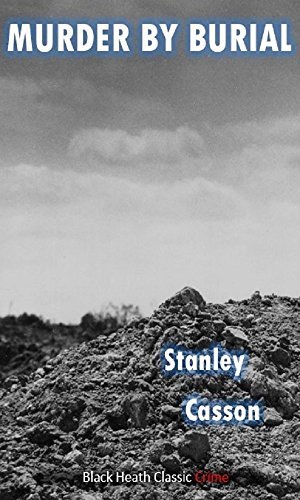A review of Murder by Burial by Stanley Casson – 240330
Stanley Casson was a prominent British archaeologist in his day and I remember dipping into some of his works when I was studying Ancient History at university. Murder by Burial, originally published in 1938, is in truth not much of a murder mystery as there is really only one credible suspect. A third or, to be charitable, a 2.2 it is easy to see why having got the urge to dabble in crime fiction out of his system, he went on to concentrate on his day job.
The dangers associated with unguarded excavations is a theme that I have come across before, in Ngaio Marsh’s later Hand in Glove (1962) and archeology as a medium for a hoax in Chesterton’s earlier Curse of the Golden Cross (1926). That said, the method of dispatching the victim, an archaeological site salted with supposedly rare artefacts from the pre-Roman British era to whet the victim’s appetite such that he digs and stands in the exact spot necessary for the excavation to collapse and kill the archaeologist. It is a crime, once set up, that can be committed in absentia as the geological and gravitational forces will work on their own, providing the saboteur with the perfect alibi.
The victim is Canon Burbery, who is convinced that there are the remains of a British settlement associated with Cynobeline on the outskirts of Kynchester, and obtains permission to carry out an exploratory archaeological dig. At the same time Colonel Cackett is rallying the townsfolk to honour the Roman emperor, Claudius, as the bringer of civilisation to a barbaric Britain and is establishing a proto-Fascist group of locals who parade up and down the town. Cackett gets mixed up with some altogether more sinister individuals, particularly Captain Antrobus, and is strongarmed into storing guns, ammunition and hand grenades in a well.
There is a long-running sense of animus between Burbery and Cackett, the canon despising the latter’s academic pretensions, even going to the lengths of blackballing his application to join a distinguished academic society, while the Colonel seeks to gain his revenge by siting a statue of Claudius close to the archaeological site.
In tone, the book falls into two distinct parts. The first can be viewed as a witty, acerbic satire of English society, especially in a rural town where petty rivalries and jealousies are magnified out of proportion. There are some genuinely funny parts but there is also a darker side. Rather like Nicholas Blake in The Smiler with the Knife, published a year later, Casson recognizes that the threat to all that we hold dear lies not from the left but from the right with their faux patriotism and their glorification of strong leaders. There is no coincidence that the statue of Claudius when unveiled is making the Fascist salute. We may find their activities vaguely amusing, somewhat distasteful but we allow their canker to fester at our peril, a lesson as relevant today as it was in the lead up to the Second World War.
Once the canon is killed, the tone of the book shifts as it becomes a slightly more conventional whodunit. While the official line is that it was an unfortunate accident, the arrival of the Bowman brothers, Andrew an archaeologist and John an architect, prove, even to Inspector Meatyard’s satisfaction, that it was the result of an ingenious and deliberate booby trap, primed only by someone with engineering knowledge. The discovery of the firearms cooks the Colonel’s goose but he, conveniently, eludes justice and the truth is contained to those who need to know.
Meatyard is a fascinating and sympathetic policeman who is prone to moments of almost philosophic reflection who recognizes that successful detection is the result of teamwork between professionals and amateurs rather than down to the genius of one individual. There is also a fascinating discussion as to whether a murder such as this, committed in absentia, is really a murder and whether a jury would see it as such.
The old adage is that there is a novel inside everyone and and Casson dug his out to poke fun at the expense of dilettante, amateur architects and sound warnings about the rise of the Fascists. The rider is that that is where it is best kept, but rather like an archaeological dig there is some interest amongst the dross. It is a curiosity from a man who devoted his life to studying curiosities.
